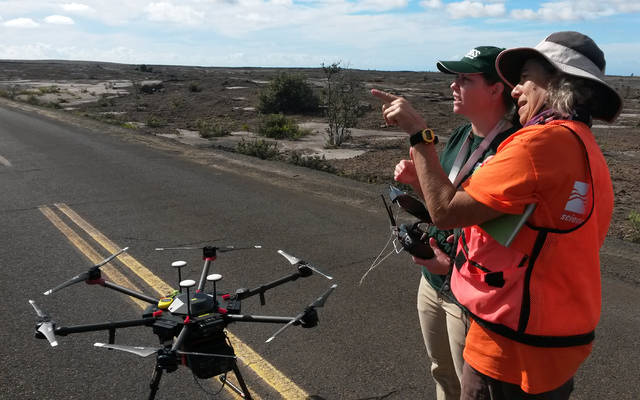Low sulfur emissions mean a new focus on a different volcanic gas

VOLCANOES NATIONAL PARK With the end of Kilaueas 2018 lower East Rift Zone eruption, Hawaii Island was able, at long last, to say goodbye to strong vog volcanic smog produced by voluminous sulfur dioxide (SO2) emissions.
VOLCANOES NATIONAL PARK — With the end of Kilauea’s 2018 lower East Rift Zone eruption, Hawaii Island was able, at long last, to say goodbye to strong vog — volcanic smog produced by voluminous sulfur dioxide (SO2) emissions.
Currently, SO2 emissions on Kilauea are drastically lower than they have been for decades. However, some SO2 is still present, in addition to rotten, egg-scented hydrogen sulfide (H2S).
So, sulfur smells are still sometimes detected around the island, but it’s another gas emitted by Kilauea that has become more important lately — carbon dioxide (CO2).
CO2 is a significant volcanic emission, along with the familiar sulfur gases, water vapor, and trace amounts of other gases, such as hydrogen chloride, hydrogen fluoride, and helium. What’s important about CO2 specifically is that it can give clues about the depth of magma.
To explain, we’ll use something familiar to everyone — a bottle of soda, which has only one gas (CO2) dissolved in it. This CO2 stays dissolved as long as the bottle is sealed, because the bottle creates enough pressure to keep the CO2 in the liquid. As soon as the bottle is opened, pressure on the liquid decreases and the CO2 creates bubbles that escape to the atmosphere.
Unlike soda, magma has many different gases dissolved in it, and they don’t all behave the same way. With soda, one pressure decrease is enough to release all the gas from it, but with magma, different degrees of pressure decrease result in the release different gases.
Since pressure on magma is created by the weight of the earth above it, the deeper magma is, the higher the pressure it feels. As magma rises to shallower depths, it feels lesser amounts of pressure and different gases are able to escape along the way.
When magma is shallow or actually reaches the surface, the pressure on it is quite low, so SO2 can easily escape, leading to the vog that impacted island residents for so long. But when magma is deeper, as is the case now, there is enough pressure to keep the SO2 dissolved.
However, CO2 is less soluble than SO2 in magma and can escape even when magma is deep and the pressure is high. This is why, even with no lava erupting at the surface, Kilauea is currently producing significant amounts of CO2. It’s important to note that these amounts are very small compared to anthropogenic, or human-caused, CO2 emissions. It’s this CO2, in conjunction with the small amounts of sulfur gases still being emitted, that can provide clues to how deep Kilauea’s magma is.
Because CO2 can escape even when magma is deep but SO2 mostly stays dissolved until the magma is shallow, deeper magma produces a high ratio of CO2 to SO2. Geochemists typically use this CO2/SO2 ratio as an indication of magma depth.
Deep magma may begin with a high CO2/SO2 ratio, but that ratio will drop as magma moves to shallower depths and more SO2 begins to escape. Therefore, if we can measure Kilauea’s CO2/SO2 ratio over time, any changes in it could tell us whether magma is once again rising through the system.
The catch is that we must be able to measure the CO2/SO2 ratio. However, accurately measuring the CO2/SO2 ratio in volcanic gas is tricky because of the large and variable amount of CO2 that already exists in the atmosphere. At Kilauea, the situation is further complicated by collapse events that rearranged the summit caldera and damaged roads and other means of access to degassing areas.
As this new phase of inactivity at Kilauea continues, gas geochemistry scientists at the USGS Hawaiian Volcano Observatory will explore new avenues for measuring the helpful CO2/SO2 ratio, including the installation of multi-gas sensors at Kilauea’s summit and the use of gas sensors mounted on unmanned aerial systems (UAS). Our goal in collecting such gas data is to document changes that could eventually indicate an increased likelihood of renewed activity at Kilauea.
Volcano Activity Updates
Kilauea is not erupting. Rates of seismicity, deformation, and gas release have not changed significantly over the past week.
Three earthquakes with three or more felt reports occurred in Hawaii during the past week: a magnitude-1.6 quake 2 miles southwest of Volcano at 3:02 a.m. on Feb. 17; a magnitude-3.0 quake 6 miles south of Kapaau at 7 miles depth on at 12:04 a.m. Feb. 17; and a magnitude-3.3 quake 8 miles east of Honokaa at 4 miles depth at 4:42 p.m. Feb. 13.
Deformation signals are consistent with refilling of Kilauea Volcano’s deep East Rift Zone (ERZ). Sulfur dioxide emission rates in the lower ERZ have been below detection limits since early September. Sulfur dioxide emissions at Kilauea’s summit and middle ERZ remain low, with rates steady over the past several weeks.
Hazardous conditions still exist at both the lower ERZ and summit of Kilauea. Residents and visitors in the lower Puna District and Kilauea summit areas on Hawaii Island should stay informed and heed Hawaii County Civil Defense closures, warnings, and messages. HVO continues to closely monitor Kilauea for any sign of increased activity.
The USGS Volcano Alert level for Mauna Loa remains at normal.
Please visit HVO’s website (https://volcanoes.usgs.gov/hvo) for past Volcano Watch articles, Kilauea and Mauna Loa updates, volcano photos, maps, recent earthquake info, and more. Call 967-8862 for weekly Kilauea updates. Email questions to askHVO@usgs.gov.
Volcano Watch is a weekly article and activity update written by U.S. Geological Survey Hawaiian Volcano Observatory scientists and affiliates.


